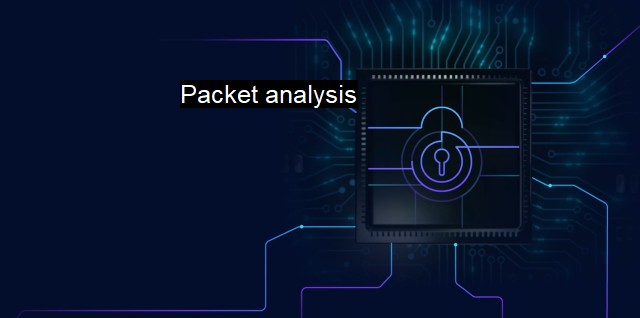What are Packet analysis?
The Essentials of Packet Analysis for Cybersecurity: Importance, Techniques, and Tools for Effective Threat Detection in Antivirus Solutions
Packet analysis, also known as packet sniffing or packet capturing, is a significant approach deployed in cybersecurity to monitor network traffic. By detailing the contents of packets of data transmitted over internet protocols (IPs), packet analysis can address several safety issues within an online or wireless network. It enables network administrators and security experts to diagnose and resolve network problems, make robust security analyses, and understand network performance. Its importance in cybersecurity cannot be overstated given the extensive use of packet analysis in prevention and detection of potentially malicious traffic.A data packet, as the most basic unit of communication over networks, consists of control information and user data. The control information provides data for delivering the payload (user data) in aspects such as source and destination network addresses, error detection codes, and sequencing information. The user data refers to the actual transmitted messages. The act of packet analysis, therefore, happens automatically and involves the scrutiny of the composition of individual packets to better understand a network's activity.
Typically, packet analysis mostly focuses on TCP/IP networks which constitute the majority of global, online communication networks. The nature of protocol used, the IP addresses involved, packet size, time stamp, packet number, etc., can tell a discerning observer a great deal about a particular network transmission. It's like listening to a digital heartbeat and provides insights into the network's internal, necessary factors reflecting its health.
In the cybersecurity sector, packet analysis forms an essential part of an antivirus strategy to safeguard networks. The information obtained through packet analysis aids in observing the behaviour of packets within the network. Specialists look for abnormal patterns in data transmission that could signify threat behaviour, such as a distributed denial-of-service (DDoS) attack or the intrusion of ransomware. Further packet analysis can point in the direction of the offending server, simplifying mitigation steps. For this reason, cybersecurity professionals often make use of packet analysis in intrusion detection systems (IDS) as a preventative measure to detect dangerous traffic before any damage.
Sometimes, cybercriminals could attempt to breach packets with a popular method called packet forging, crafting their packets or manipulating existing packets for illicit activities such as spoofing. Here, packet analysis can uncover altered packets, scouting for potentially malicious contents by comparing the control information with a predefined secure state or baseline traffic patterns. It becomes possible to pinpoint instances of cyber threats, in turn, this information helps in tracking and blocking the origin of threats.
On top of that, packet analysis is beneficial in post-threat analysis. Following a cyber attack, dissecting what went wrong and where it took place is integral for future-proofing security systems and protocols. Packet analysers audit network transmissions retrospectively to understand the attack's nature and how to prevent similar occurrences. It's why antivirus software leverages the power of packet analysis
Packet analysis itself isn't free of security issues. Given its comprehensive investigative power, misusing packet analysis can result in harmful practices – imagine forging packets or eavesdropping for espionage. Still, these circumstances should not dissuade its efficient application but rather stress the need for safer packet analysing methods.
Packet analysis is a crucial pillar of cybersecurity measures and antivirus programmes. Enhancing understanding of the network's performance and communications, packet analysis is vital for diagnosing network issues, securing network transmissions, and averting cyber threats. Its potent detection and preventive tools underscore its imperative role in modern digital communication. constant vigilance in its use is essential given the potential for its misuse in the wrong hands. These proactive measures through packet analysis ultimately contribute to designing secure networks and safe digital spaces.

Packet analysis FAQs
What is packet analysis?
Packet analysis involves examining network packets transmitted between devices that are connected to a network in order to identify and investigate issues or security incidents. It involves capturing, analyzing, and interpreting different types of network traffic data.Why is packet analysis important in cybersecurity?
Packet analysis is important in cybersecurity as it allows security analysts to monitor network traffic and identify potential security threats such as malware, intrusions, and attempts to exploit vulnerabilities. It helps in detecting and mitigating security incidents and enhances the overall security posture of an organization.What are the benefits of packet analysis in antivirus software?
Packet analysis can be used in antivirus software to identify and analyze suspicious files or packets that may contain malware. It can help in detecting and removing malware infections, and also in identifying new types of malware that may not have been seen before. It can also assist in developing more effective antivirus solutions by analyzing malware behavior and patterns.What are some tools used for packet analysis?
There are several tools used for packet analysis, including Wireshark, tcpdump, Microsoft Network Monitor, and SolarWinds Network Performance Monitor. These tools allow network traffic to be captured, filtered, and analyzed to identify issues and security incidents.| | A | | | B | | | C | | | D | | | E | | | F | | | G | | | H | | | I | | | J | | | K | | | L | | | M | |
| | N | | | O | | | P | | | Q | | | R | | | S | | | T | | | U | | | V | | | W | | | X | | | Y | | | Z | |
| | 1 | | | 2 | | | 3 | | | 4 | | | 7 | | | 8 | | |||||||